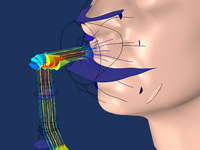

The default Global Evaluation node, the settings, and the associated table (bottom right) from the Dielectric Slab Waveguide tutorial model.

When the study does not perform any sweeps, instead of a default plot, a global evaluation is evaluated in a table for the reflectance and transmittance variables.

In addition, there are summation variables for the total reflectance, total transmittance, total reflectance and transmittance, and the absorptance.įor frequency or wavelength sweeps, parametric sweeps, and auxiliary sweeps, new default plots of the reflectances and transmittances are generated. For instance, the variable ewfd.Rorder_p1_op represents the reflectance, for a 2D mode, with order 1 and out-of-plane polarization. Similarly, when periodic ports and diffraction order ports are used, there are new variables based on the mode number and the mode polarization. The variables named ewfd.Rport_ and ewfd.Tport_ are based on the port name. For instance, instead of writing abs(ewfd.S11)^2 for the reflectance at port 1, you can now simply write ewfd.Rport_1. New postprocessing variables have been introduced to simplify the evaluation of reflectance, transmittance, and absorptance expressions.

As the name suggests, the paraxial approximation is only an approximate solution to the Helmholtz equation that should not be used to represent tightly focused Gaussian beams.Īpplication Library path for an example using the Helmholtz-compliant Gaussian beam background field: Wave_Optics_Module/Optical_Scattering/nanorods New Postprocessing and Visualization Tools for Reflectance and Transmittance The advantage of this implementation as compared to the paraxial approximation implementation is that the plane-wave expansion implementation is a true solution to the Helmholtz equation, as each plane wave is a solution to the Helmholtz equation. Helmholtz-Compliant Gaussian Beam Background FieldĪ new Gaussian beam background field implementation is available, where the beam focal plane is approximated using a summation of plane waves that are propagating with wave vectors pointing in a distribution around the main propagation direction. When you add a frequency- or wavelength-dependent study step, for instance the Wavelength Domain or the Frequency Domain study step, together with either of the Electromagnetic Waves, Frequency Domain or Electromagnetic Waves, Beam Envelopes physics interfaces, a default wavelength of 1 μm will be used. The new Physics-Controlled Mesh section of the Electromagnetic Waves, Beam Envelopes interface settings, as exemplified for the Directional Coupler tutorial model.Īpplication Library paths for examples using the new physics-controlled mesh: Wave_Optics_Module/Gratings_and_Metamaterials/hexagonal_grating Wave_Optics_Module/Gratings_and_Metamaterials/negative_refractive_index Wave_Optics_Module/Gratings_and_Metamaterials/plasmonic_wire_grating Wave_Optics_Module/Optical_Scattering/beam_splitter Wave_Optics_Module/Optical_Scattering/brewster_interface Wave_Optics_Module/Optical_Scattering/nanorods Wave_Optics_Module/Optical_Scattering/scattering_nanosphere Wave_Optics_Module/Verification_Example/dielectric_slab_waveguide Wave_Optics_Module/Verification_Example/fresnel_equations Wave_Optics_Module/Verification_Example/symmetric_laser_cavity Wave_Optics_Module/Waveguides_and_Couplers/directional_coupler Wave_Optics_Module/Waveguides_and_Couplers/optical_ring_resonator Wave_Optics_Module/Waveguides_and_Couplers/photonic_crystal Wave_Optics_Module/Waveguides_and_Couplers/step_index_fiber_bend Default Wavelength for Study Steps


 0 kommentar(er)
0 kommentar(er)
